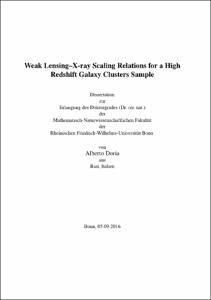Weak Lensing–X-ray Scaling Relations for a High Redshift Galaxy Clusters Sample

Weak Lensing–X-ray Scaling Relations for a High Redshift Galaxy Clusters Sample

| dc.contributor.advisor | Reiprich, Thomas H. | |
| dc.contributor.author | Doria, Alberto | |
| dc.date.accessioned | 2020-04-23T23:14:17Z | |
| dc.date.available | 2020-04-23T23:14:17Z | |
| dc.date.issued | 21.07.2017 | |
| dc.identifier.uri | https://hdl.handle.net/20.500.11811/7195 | |
| dc.description.abstract | Accurate cosmology through large X-ray selected galaxy cluster samples will rely on accurate mass estimates and well-calibrated mass-observable relations. The comparison of independent approaches, such as X-ray and gravitational lensing analysis, yields the most accurate results in tracing the cosmic evolution. This also contributes to improve our understanding of the scaling laws between X-ray luminosity and mass, providing the essential connection between observations and cosmological constraints that will be obtained thanks to the forthcoming eROSITA X-ray space telescope. Our project aims at the mass estimation via the weak lensing follow-up of the cosmological subsample of the 400d Galaxy Cluster Survey: a homogeneous, statistically complete and flux limited X-ray sample of 36 high-redshift (0.35 ≤ z < 0.90) clusters, covering an as yet unexplored region in the mass-redshift parameter space. After a brief introduction about cluster cosmology, this thesis presents methods and results of the cluster mass estimation through an homogeneous weak lensing analysis of 18 galaxy clusters. For our purposes we use optical data from archival and granted observations at ground-based instruments: IMACS, WFI and MegaCam wide-field cameras. Given the poor quality of the data format of the IMACS camera, we modify and automatize the THELI data reduction pipeline and implement a method for recovering precious astrometric information. We provide revised scaling relations of weak lensing mass with several X-ray observables integrating the new data with updated masses from the previous works, basing on a total of 25 high-z clusters. We compare our results with the X-ray mass estimates and recent mass comparison projects. We find a hint for a mass-dependent mass bias, with X-ray mass estimates of low-mass clusters (w.r.t. the sample median mass) being biased-high, while they are biased-low at the high-mass end. However, the overall trend is consistent with the zero bias, hence not showing any indication for a strong cluster mass bias which would be needed to alleviate the Planck CMB-cluster tension. | |
| dc.language.iso | eng | |
| dc.rights | In Copyright | |
| dc.rights.uri | http://rightsstatements.org/vocab/InC/1.0/ | |
| dc.subject.ddc | 520 Astronomie, Kartografie | |
| dc.subject.ddc | 530 Physik | |
| dc.title | Weak Lensing–X-ray Scaling Relations for a High Redshift Galaxy Clusters Sample | |
| dc.type | Dissertation oder Habilitation | |
| dc.publisher.name | Universitäts- und Landesbibliothek Bonn | |
| dc.publisher.location | Bonn | |
| dc.rights.accessRights | openAccess | |
| dc.identifier.urn | https://nbn-resolving.org/urn:nbn:de:hbz:5n-47514 | |
| ulbbn.pubtype | Erstveröffentlichung | |
| ulbbnediss.affiliation.name | Rheinische Friedrich-Wilhelms-Universität Bonn | |
| ulbbnediss.affiliation.location | Bonn | |
| ulbbnediss.thesis.level | Dissertation | |
| ulbbnediss.dissID | 4751 | |
| ulbbnediss.date.accepted | 11.04.2017 | |
| ulbbnediss.institute | Mathematisch-Naturwissenschaftliche Fakultät : Fachgruppe Physik/Astronomie / Argelander-Institut für Astronomie (AIfA) | |
| ulbbnediss.fakultaet | Mathematisch-Naturwissenschaftliche Fakultät | |
| dc.contributor.coReferee | Schneider, Peter |
Files in this item
This item appears in the following Collection(s)
-
E-Dissertationen (4077)




